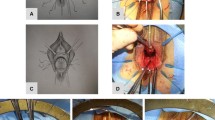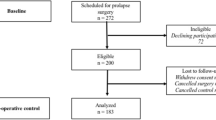Abstract
Introduction and hypothesis
Female pelvic organ prolapse recurrence has been shown to be associated with levator hiatal distensibility. Reducing hiatal size surgically may reduce recurrence risk. This study aims to demonstrate a novel surgical procedure, the puborectalis sling (PR sling), designed to reduce the levator hiatal area, and to assess the medium-term safety and efficacy of this procedure.
Methods
One hundred fifteen women undergoing prolapse repair with a pre-operative hiatal area on Valsalva of ≥ 35 cm2 were recruited into this phase 1 prospective multicentre pilot study. All underwent a PR sling procedure after completion of standard repairs. Primary outcome was levator hiatal area measured on ultrasound.
Results
One hundred ten patients were evaluated at least 3 months post-operatively. At 2.5 years average follow-up, there was an average of 12 cm2 (range 6–16 cm2) reduction in hiatal area from a mean pre-operative hiatal area of 43.9 (35–63) cm2. Thirty per cent (28/93) were symptomatic of prolapse, 66% (61/93) had clinical prolapse recurrence whilst 49% (46/93) had sonographic recurrence. Three patients required a return to theatre; one case of infection resulted in mesh removal, one had severe obstructed defecation requiring sling loosening and another had buttock pain with faecal impaction that resolved after manual disimpaction. There were no long-term sequelae.
Conclusions
The levator hiatal area can be reduced surgically, with almost 30% reduction in area seen in this pilot study. The reduction was significant and sustained up to 2 years with no major long-term complications.


Similar content being viewed by others
Abbreviations
- Gh:
-
Genital hiatus
- Pb:
-
Perineal body
- POP:
-
Pelvic organ prolapse
- POPQ:
-
Pelvic organ prolapse quantification
- PR:
-
Puborectalis
- TOPAS:
-
Transobturator Post-anal sling
- US:
-
United States of America
References
Brubaker L, Maher C, Jacquetin B, Rajamaheswari N, von Theobald P, Norton P. Surgery for pelvic organ prolapse. Female Pelvic Medicine & Reconstructive Surgery. 2010;16(1):9–19.
Olsen AL, Smith VJ, Bergstrom JO, Colling JC, Clark AL. Epidemiology of surgically managed pelvic organ prolapse and urinary incontinence. Obstet Gynecol. 1997;89:501–6.
Smith F, Holman D, Moorin R, Tsokos N. Lifetime risk of undergoing surgery for pelvic organ prolapse. Obstet Gynecol. 2010;116:1096–100.
Hagen S, Stark D. Conservative prevention and management of pelvic organ prolapse in women. Cochrane Database Syst Rev. 2011;12:CD003882.
Altman D, Väyrynen T, Ellström Engh M, Axelsen S, Falconer C. Anterior colporrhaphy versus transvaginal mesh for pelvic-organ prolapse. New Engl J Med. 2011;364:1826–36.
Feiner B, Jelovsek J, Maher C. Efficacy and safety of transvaginal mesh kits in the treatment of prolapse of the vaginal apex: a systematic review. Br J Obstet Gynaecol. 2009;116:15–24.
Model A, Shek KL, Dietz HP. Levator defects are associated with prolapse after pelvic floor surgery. Eur J Obstet Gynecol Reprod Biol. 2010;153:220–3.
Dietz HP, Chantarasorn V, Shek KL. Levator avulsion is a risk factor for cystocele recurrence. Ultrasound Obstet Gynecol. 2010;36:76–80.
Wong V, Shek K, Rane A, Goh J, Krause H, Dietz H. Is levator avulsion a predictor of cystocele recurrence following anterior vaginal mesh placement? Ultrasound Obstet Gynecol. 2013;42:230–4.
Friedman T, Eslick GD, Dietz HP. Risk factors for prolapse recurrence: systematic review and meta-analysis. Int Urogynecol J. 2017. https://doi.org/10.1007/s00192-017-3475-4.
Rodrigo N, Wong V, Shek KL, Martin A, Dietz HP. The use of 3-dimensional ultrasound of the pelvic floor to predict recurrence risk after pelvic reconstructive surgery. Aust N Z J Obstet Gynaecol. 2014;54:206–11.
Kearney R, Miller J, Ashton-Miller J, Delancey J. Obstetric factors associated with levator ani muscle injury after vaginal birth. Obstet Gynecol. 2006;107:144–9.
Dietz H, Lanzarone V. Levator trauma after vaginal delivery. Obstet Gynecol. 2005;106:707–12.
Dietz H, Simpson J. Levator trauma is associated with pelvic organ prolapse. Br J Obstet Gynaecol. 2008;115:979–84.
DeLancey J, Morgan D, Fenner D, Kearney R, Guire K, Miller J, et al. Comparison of levator ani muscle defects and function in women with and without pelvic organ prolapse. Obstet Gynecol. 2007;109:295–302.
Shek K, Dietz H. Intrapartum risk factors of levator trauma. Br J Obstet Gynaecol. 2010;117:1485–92. https://doi.org/10.1111/j.1471-0528.2010.02704.x.
Shek K, Chantarasorn V, Langer S, Dietz H. Does levator trauma ‘heal’? Ultrasound Obstet Gynecol. 2012;40:570–5.
Rosenblatt P. Trans-obturator post-anal sling (TOPAS) procedure for fecal incontinence. J Minim Invasive Gynecol. 2007;14:S152.
Gerges B, Atan IK, Shek K, Dietz H. How to determine “ballooning” of the levator hiatus on clinical examination: a retrospective observational study. Int Urogynecol J. 2013;24:1933–7.
Dietz H. Ultrasound imaging of the pelvic floor. Part II: three-dimensional or volume imaging. Ultrasound Obstet Gynecol. 2004;23:615–25.
Dietz H. Ultrasound imaging of the pelvic floor: part 1: 2D aspects. Ultrasound Obstet Gynecol. 2004;23:80–92.
Dietz HP, Wong V, Shek KL. A simplified method for determining hiatal biometry. Aust N Z J Obstet Gynaecol. 2011;51:540–3.
Dietz H, Bernardo M, Kirby A, Shek K. Minimal criteria for the diagnosis of avulsion of the puborectalis muscle by tomographic ultrasound. Int Urogynecol J. 2011;22:699–704.
Dietz H, Abbu A, Shek K. The Levator urethral gap measurement: a more objective means of determining levator avulsion? Ultrasound Obstet Gynecol. 2008;32:941–5.
Zacharin RF, Hamilton NT. Pulsion enterocele: long-term results of an abdominoperineal technique. Obstet Gynecol. 1980;55:141–8.
Mellgren A, Zutshi M, Lucente VR, Culligan P, Fenner DE, Chern H, et al. A posterior anal sling for fecal incontinence: results of a 152-patient prospective multicenter study. Am J Obstet Gynecol. 2016;214:349. e341–8.
Barber MD. Symptoms and outcome measures of pelvic organ prolapse. Clin Obstet Gynecol. 2005;48:648–61.
Author information
Authors and Affiliations
Corresponding author
Ethics declarations
Conflicts of interest
HP Dietz and KL Shek have received unrestricted educational grants from GE. No other conflicts of interest to declare by other authors.
Additional information
Publisher’s note
Springer Nature remains neutral with regard to jurisdictional claims in published maps and institutional affiliations.
This was presented as an e-poster at IUGA 42nd ASM, Vancouver, June 2017.
Rights and permissions
About this article
Cite this article
Wong, V., Shek, K.L., Korda, A. et al. A pilot study on surgical reduction of the levator hiatus—the puborectalis sling. Int Urogynecol J 30, 2127–2133 (2019). https://doi.org/10.1007/s00192-019-04062-0
Received:
Accepted:
Published:
Issue Date:
DOI: https://doi.org/10.1007/s00192-019-04062-0




